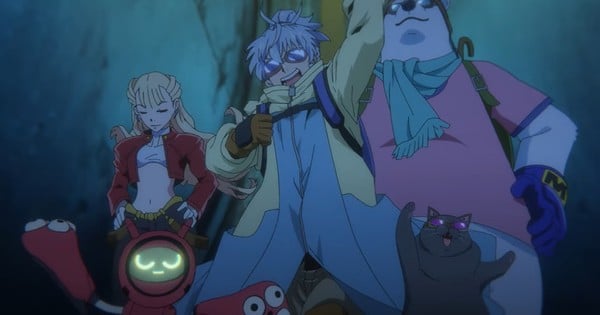This first set of eight episodes is the story of a heist gone wrong—or one gone right, depending on your point of view. Gear, our starry-eyed youth, is a kid enraptured by the idea of an outlaw lifestyle who is being held back by his love for his sickly father figure. However, once his two goals overlap (the heist will get him enough money to finance his freedom and get his father figure medicine), he’s all in on the plan—even when it’s obvious that he shouldn’t be.
Despite being the main character, Gear is the least interesting of our main cast. He’s a rather one-note character, driven by the old classics of a need for adventure and the love of his found family. The rest of the group is where things get more interesting.
Shirokuma is, for all appearances, a walking, talking polar bear. He’s strong, yet cowardly; street-smart yet unable to control his greed. And the more we learn about him, the more complex he becomes—and his friendship with the rest of the team feels all the more bittersweet.
Then there is Qu-0213, a robot with multiple personality disorder. Rather than one character, it is four in one, with each serving as a different kind of family member for Gear. We have everything from the sympathetic big sister to the kindly grandmother.
And finally, we get the aforementioned femme fatale of the show, Noah. At first, Noah seems like your typical Fujiko Mine character—a beautiful, cunning ally to our hapless group of thieves who is fine with betraying the group the moment it’s in her best interest to do so. Yet, as the anime continues, we see there is much more depth to her, and the more trust Gear and his friends put in her, the more loyal she becomes. All together, the four make for a great set of characters to head off on an adventure with—and what a stylish adventure this is.
Both the art and animation in BULLET/BULLET are top tier. The gritty city, the wasteland, and the governmental district all feel surprisingly real, lived-in locations. Then come the objects that inhabit this world. While taking place in the far future, there is an odd mix of futuristic and analog technologies. You have AI-driven mecha and flying drones alongside 3.5-inch floppy discs, cassette tapes, and VHS tapes. But the real show-stealer in design? Noah’s bike looks like a Lockheed P-38 Lightning airplane reimagined as a road vehicle.
Then comes the animation. The action scenes—especially those involving “Bullet”, Gear’s car—are amazing. It’s got the kind of “car-fu” action you see in Hollywood movies taken to the next level thanks to its animated nature. This means you get impossible camera angles and the like, making for something that, at times, feels more like a game than something from TV or movies.
There is also an amazingly artistic scene that deserves mention. The flashback of Gear’s childhood is animated in the style of a moving oil painting. Not only is it beautiful, but the lack of visual clarity in the art style is the perfect fit for something like half-remembered childhood memories. It’s a fantastic sequence.
The music is likewise great. Not only does it do its job in the action scenes, with great vocals accentuating the excitement in the insert songs, but in the more somber moments, as well. Then there’s the opening (which has the characters in what feels like a hip-hop music video) and the ending (which feels like a rock ballad from the 90s). It’s an above-average soundtrack, to say the least.
Now that we’ve covered the “flash,” let’s get into the “substance” of what BULLET/BULLET is. On its most basic level, this first arc of episodes is a story of the rich exploiting the poor, and the poor accepting it. Even as Gear uncovers multiple dark secrets—and even reveals them to the populous at large—he is ignored at best, ridiculed at worst.
Despite risking his life to bring the truth to the masses, the people are content with their oppression. They view their living and working conditions as normal. Even the idea that the upper class is not only living in luxury off their slave labor but is also siphoning their very life force is not enough to make the people care. They have no dreams—they are content with food, booze, and basic entertainment. They’re so far gone, they have been conditioned to celebrate, not mourn, when their friends work themselves to death.
It’s not hard to see this all as an allegory for the modern day, where the rich get richer and everyone else gets poorer. All the while, the majority simply accept it as normal and focus more on TV, movies, and games than the issues facing them in the real world. If anything, this series champions those willing to stand up and try to speak the truth, even as it shows that it is likely to fall on deaf ears.
In the end, this first arc of BULLET/BULLET ends on a major downer as Gear and the crew sacrifice their freedom in a noble act, only for their hopes to be completely betrayed. With our heroes now at their lowest point, we’ll have to tune into the second part of the series to see how they grapple with what they’ve learned about human nature and if they can find a reason to continue.
![]()
Dil Nawaz — a writer who breathes life into emotions through words. I find beauty in silence, meaning in longing, and stories in every heartbeat. Writing for me isn’t just passion; it’s a way to connect souls, one feeling at a time.
